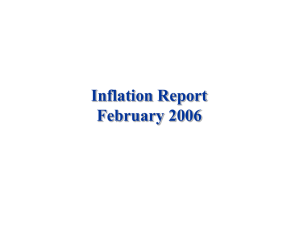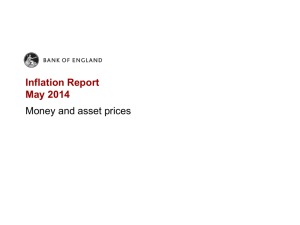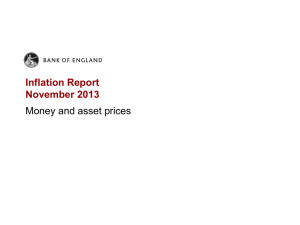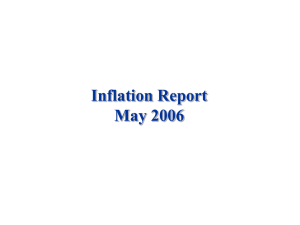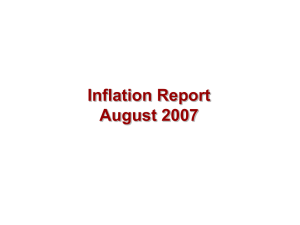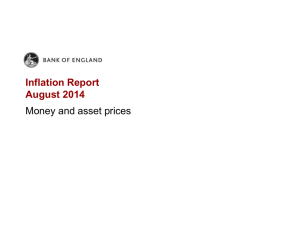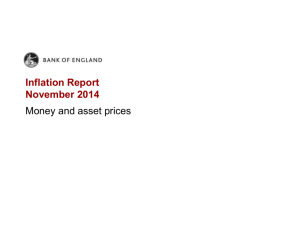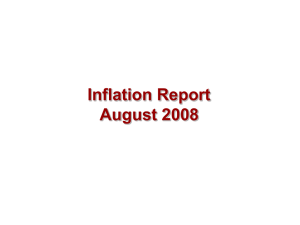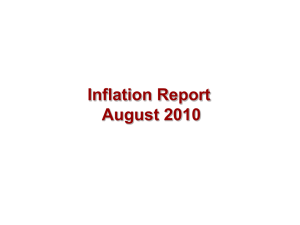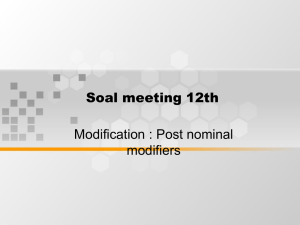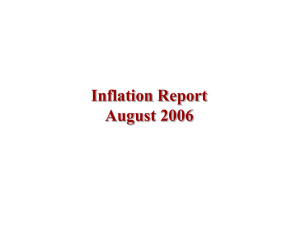Inflation Report February 2007
advertisement
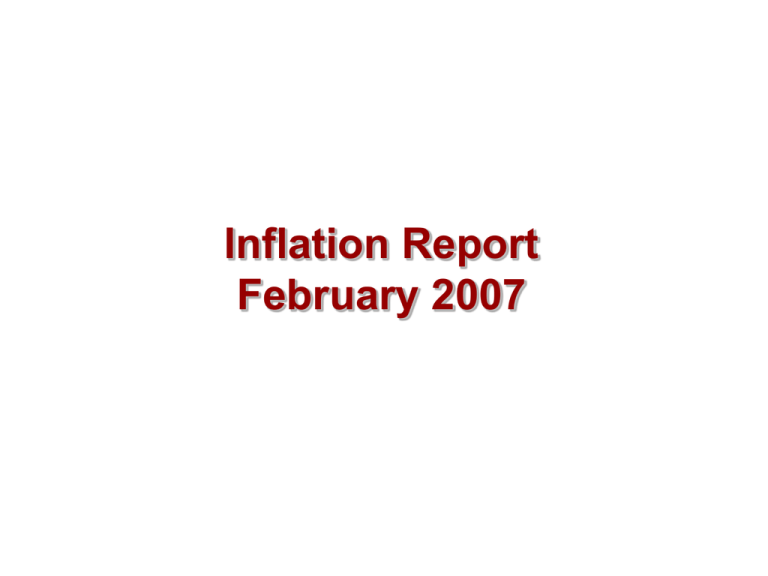
Inflation Report February 2007 Money and asset prices Chart 1.1 Bank Rate and one-day forward curves(a) Sources: Bank of England and Bloomberg. (a) Forward rates are derived from instruments that settle on the London interbank offered rate. That includes market rates on short sterling futures, swaps, interbank loans and forward rate agreements. The forward curves shown in the chart are fifteen-day averages of one-day forward rates. The curves have been adjusted for credit risk. Chart 1.2 Nominal long-term forward interest rates(a) Sources: Bank of England and Bloomberg. (a) Instantaneous forward rates ten years ahead. Chart 1.3 Medium-term breakeven inflation rates(a) Sources: Bank of England and Bloomberg. (a) Implied instantaneous inflation rates five and ten years ahead, based on the difference between yields on nominal and inflation-linked government bonds. The instruments used are linked to RPI, rather than CPI, and so are not directly comparable to the Bank’s inflation target. Chart 1.4 Decomposition of annual percentage changes in the FTSE 100(a) Sources: Bank of England, Bloomberg and Thomson Financial Datastream. (a) Decomposition of the changes in each year to December using a dividend discount model. See footnote (1) on this page for reference. (b) Based on current dividends and analysts’ expectations of long-term earnings growth. (c) Ten-year real spot rate derived from government bonds. Chart 1.5 Cumulative changes in sterling exchange rates since 3 April 2006 Chart 1.6 UK house prices Sources: Halifax and Nationwide. (a) The published index has been adjusted in 2002 by the Bank of England to account for a change in the method of calculation. Chart 1.7 Contributions to annual growth in non-bank financial companies’ sterling bank deposits(a) (a) These data are not directly comparable with the M4 data reported in Table 1.B. In particular, they do not cover deposits with building societies. Non seasonally adjusted. Chart 1.8 Spread over Bank Rate of deposit and loan rates for non-bank financial companies(a) (a) Effective rates on loans and deposits less Bank Rate. Chart 1.9 Lending to individuals Chart 1.10 Household effective interest rates(a) (a) Monthly data to December 2006 on the effective rates paid on the outstanding stock of secured and unsecured borrowing. Chart 1.11 Indicators of mortgage equity withdrawal (a) Excludes mortgage approvals for house purchase and refinancing of existing mortgages. Data to 2006 Q3, the latest date for which household income data are available. Chart 1.12 Contributions to annual growth in sterling bank lending to non-financial companies(a) (a) Contributions to growth in year to Q4. These data are not directly comparable with the M4 lending data. In particular, they do not cover deposits with building societies. Non seasonally adjusted. Tables Table 1.A Housing market indicators(a) Averages Average since since 2000 2000 2006 Q1 Q2 Q3 Q4 117 0.35 12 14 -3 115 0.36 15 27 5 122 0.38 19 23 2 123 0.42 6 32 9 19 21 32 28 37 37 30 44 36 Activity Mortgage approvals (000s)(b) RICS sales to stocks ratio(c) RICS new buyer enquiries(d) HBF net reservations(e)(f) HBF site visits(e)(f) 108 0.43 -1 3 -6 Prices HBF current balance(d)(f) RICS current balance(g) RICS expectations balance(g) 25 18 15 Sources: Bank of England, Home Builders Federation (HBF) and Royal Institution of Chartered Surveyors (RICS). (a) Averages of monthly data. All series are net percentage balances unless otherwise stated. (b) Loan approvals for house purchase. (c) Ratio of sales recorded over the past three months relative to the level of stocks on estate agents’ books at the end of the month. (d) Compared with the previous month. (e) Compared with a year ago. (f) Seasonally adjusted by Bank staff. (g) Change during the past three months or expected over the next three months. 8 11 23 Table 1.B Monetary aggregates(a) Percentage changes on a year earlier Notes and coin M4 of which: Households Private non-financial corporations Non-bank financial corporations Memo: Nominal GDP (a) Growth rates for money data are for the last month in each quarter. 2006 Q1 Q2 Q3 Q4 5.1 12.2 5.7 13.4 5.1 14.4 5.5 12.8 8.1 11.3 23.8 7.7 10.1 31.4 8.3 14.2 29.9 8.2 12.4 24.4 4.1 4.9 6.0 n.a. Table 1.C UK personal insolvencies(a) Percentages of adult population, annualised Average 2005 1998–2004 1998-2004 1998-2004 Total personal insolvencies of which: Bankruptcies Individual voluntary arrangements 2006 Q1 Q2 Q3 Q4 0.09 0.17 0.23 0.26 0.27 0.27 0.06 0.02 0.11 0.06 0.15 0.08 0.14 0.11 0.14 0.12 0.14 0.12 Sources: The Insolvency Service and ONS. (a) Components may not add up to the totals due to rounding. Insolvencies in Scotland take the form of sequestrations and protected trust deeds, which are broadly equivalent to bankruptcy and individual voluntary arrangements respectively. Population estimates for the three months to November used for Q4. Non seasonally adjusted. Common trends in asset prices Chart A Selected asset prices(a) Sources: Bank of England, Halifax and Thomson Financial Datastream. (a) Monthly data. All prices expressed in SDRs, an IMF unit of account. (b) Morgan Stanley Capital International index. (c) Investment Property Databank capital index for offices. Chart B Excess of global broad money growth over nominal spending growth(a) Sources: IMF, Thomson Financial Datastream and Bank of England calculations. (a) Annual growth in the stock of broad money less annual growth in nominal GDP. Country-level data have been aggregated using IMF purchasing power parity (PPP) exchange rates. (b) Data to 2005 on the stock of broad money for 175 countries and world nominal GDP, taken from the September 2006 IMF WEO database. (c) Euro area, Japan, United Kingdom and United States. The 2006 figure is for the year to Q3.
